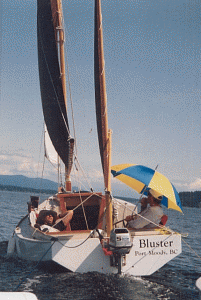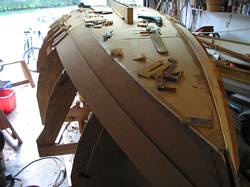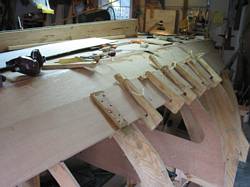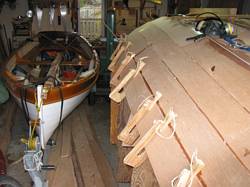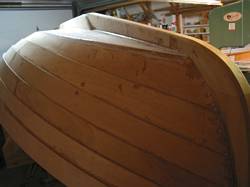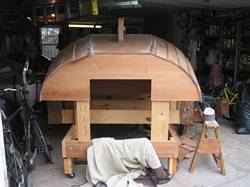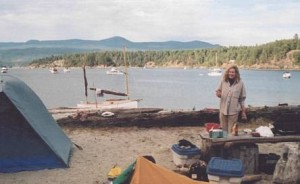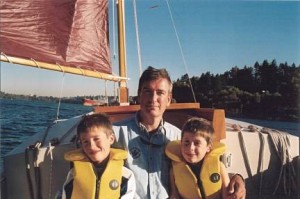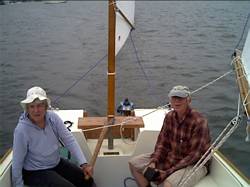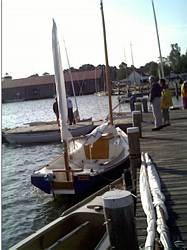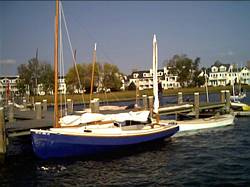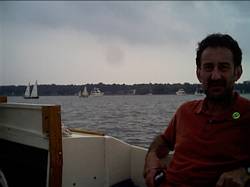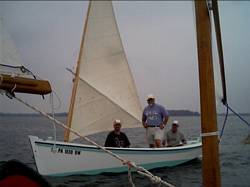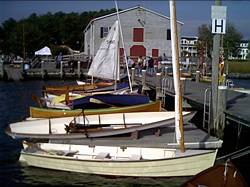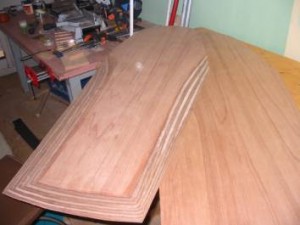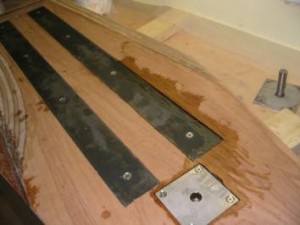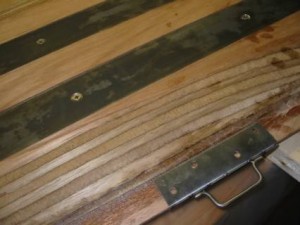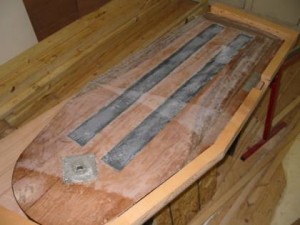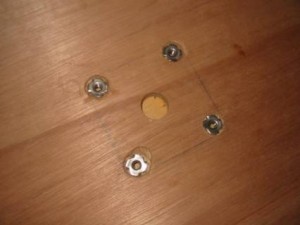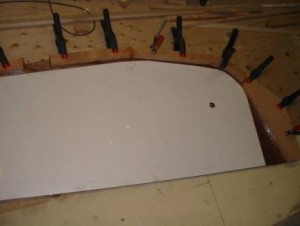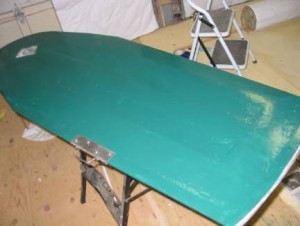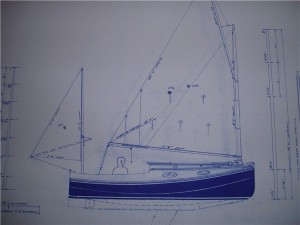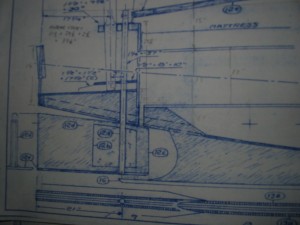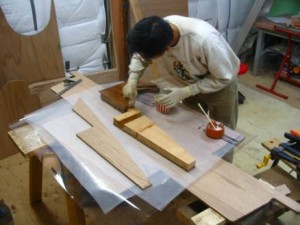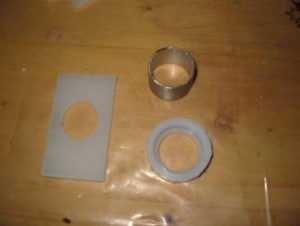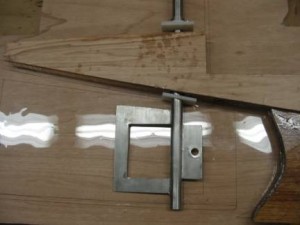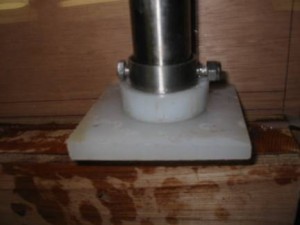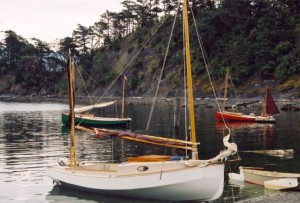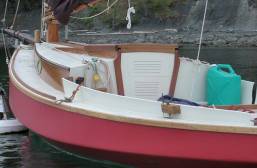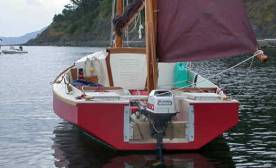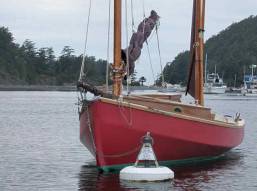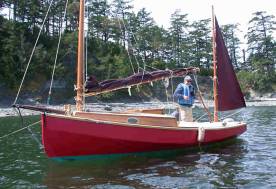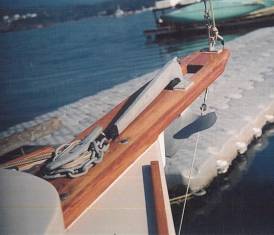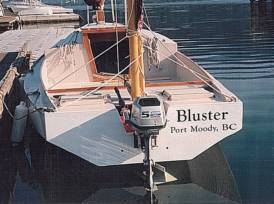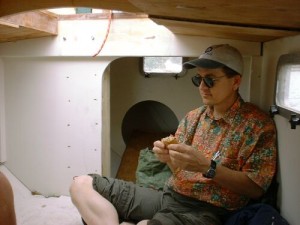News, questions, and boats for sale.
News:
| Well, the long anticipated calendar is a bust. My preferred publisher was having health and technology issues. I may still do one using cafe press, but since I only received one order for the one that didn’t work, a calendar really isn’t hight on the priority list of things to do. Been kind of quite, only took the boat out once since the last issue. You would think that being unemployed would give me plenty of time to do that, but for some reason it didn’t work out that way. I plan on going to a couple of messabouts this summer, I’ll take pictures and write something up about them.
Let’s see, we had vandals posting all kinds of php based scripts in the registry, taking advantage of the facility that was there to allow you to post pictures. I’ve locked down the registry, so if you want to edit your entries, or add a new one, just send me an email with the relevant details. You can also send a picture, if you want, and I’ll include it. Speaking of email, I was getting 300+ spams, and at least 20 trojans, a day, do I’m bouncing all email sent to my old email address. I posted the new email address on this site, but it wasn’t a couple of days before I started getting spam and worms again. I believe they scan the web and dig email addresses out of webpages. Working on that theory, I have implemented a script based form to send me email. Sorry for the inconvenience. If you are wanting to send in an article for publication, just send me an email with the form and I’ll tell you my direct email address. We have ten articles this issue, if you include this news sheet. One if even a contribution about writing contribution, (a meta article, an article about articles! hehe), by Chuck Leinweber of Duckworks fame. Thanks for all the contributions for this issue, and I hope you enjoy it. Chebacco Richard |
Questions:
|
Noted a mizzen comment by Donna D’Agostino and Vincenzo Ciminale in Italy. Pass on to them the notation a windsurfing boom for their mizzen ashes snap on in a minute, can be extended to multiple lengths and can be hyper lengthened with 1″ thin wall aluminum tubing. It would get them out of the business of “walking the boom” as they tack.
Dave Godsey
|
Chebacco’s for sale:
***
Free time and boat cruising – Richard Spelling
Well, my 9-month sojourn into the ranks of the unemployed is finally over.
I’m working night shift, on an Air Force base, 100 miles from the house, but it beats the alternative.
You know, I always thought that if I ever became unemployed, I’d just fall back on my non-IS skills, or take some low paying IS job. I found out the hard way that the companies with the lower paying IT jobs are all bargain shopping, and think you are over qualified if you have more than one certification. If the first thing they ask you when you send them your resume is “what are your salary requirements?”, this is a bad sign. Or they want you to have a BS in computer science, 10 years of experience, and then want to pay you $10 an hour…
As for working non-is type stuff, I tried that. Still have a going concern manufacturing variable output forge blowers and DC motor kits. Of all the things I tried in an attempt to rustle up money during my “vacation”, building those was the most enjoyable, and made a decent profit. And I tried a bunch of things, from mowing lawns, to doing handyman work, to doing computer consulting, to putting in concrete slabs. All doable, but not enjoyable, partly do to the physical labor involved, but also do to the fact that they involved starting over, and wasting all the time and money I’d spent getting my degree and certifications.
The kicker was calling the “work force investment” people for retraining, and being told I couldn’t go to any CDL or welding classes because I had a BS degree. (!)
Let’s see. Still don’t have a car/boat port to put the chebacco under, I’m currently using a “super tarp” I picked up on ebay. Basically a gray tarp, but not the cheap crap you get at Wal-Mart. Speaking of Wal-Mart, anybody remember when shoes lasted more than a month before the sides came apart? Sandals lasted almost as long? Remember back in the day, before Sam died, when you could return stuff to Wal-Mart if it broke? Ah, those were the days.
Anyway. Invitation to my wedding: “Oh, by the way, I’m getting married. Jan 1st, 2005, First Christian Church, Pryor, Ok. I’m marrying the preacher. Elvis will be there. You are invited.”
Yes. I got married. Again. To my ex-wife. Hey, there are no rules; I can do what I want. Besides, you really don’t know how important things are to you till you almost loose them… which is another story. And yes, Elvis was there.
So, I’m living in OKC, and in Mannford, and in Pryor. I stay in my apartment in the city during the week (horror of horrors, I hate it), go to the cabin in the woods on the weekends to work on blowers and controllers, and go visit the wife and kids in Pryor once a week. Well, shit, life sure was less complicated when I was unemployed and single. As my wife/ex-wife/wife used to say: “This damned job sure interferes with my free time!”
Incidentally, one of the options I was considering, if I didn’t find a job, and the money ran completely out, etc, was to go sailing and just not come back. Extended cruise. Got bored at work last night and got to wondering how far I could have gotten in my 20ft semi-open boat. Some reading on ocean cruises leads me to think I need to stay away from open water… <nervous laugh>
Then I got to trying to figure out how big a boat I would need… I think I like the idea of sailing into the sunset much more then I like the reality of it. I’m definitely a fair weather sailor, any waves over a foot or two just slow the boat down and annoy me. And big movements of the boat are only fun on occasion.
Maybe I do have the perfect boat. Keep this job long enough to pay everything off, then maybe instead of sailing into the sunset, I should hook the Chebacco up to the back of a nice tow vehicle, and head off to non-open water! hehe Wonder how big the waves get on Baja?
Anyway. I’ll write a more boat-oriented article for the next issue. If you don’t think I should be writing non-chebacco related articles for this webzine, feel free to write the editor… 🙂
Or, even better, send in your own boat/chebacco related stories, and I’ll publish them instead of boring you with the editor’s life!
Laters, fair weather, and stay employed.
***
Bluster, San Juan Islands – Randy Wheating
Hi Richard
Thanks for all the work on the Chebacco News.
I have attached a photo of Bluster motor sailing into Hale Passage, San Juan Islands.
This was taken by Gary Powell while under tow. Gary and his daughter Kate were sailing his engineless dory as we were all returning to launch ramp from our very enjoyable Small Boat Rendezvous on Sucia Island this past July. The wind had died off so we just tossed them a line for the final leg.
Fair winds,
Randy Wheating
Port Moody, BC
***
Chebacco Progress – Howard Sharp
Dear Richard,
Daytime temperatures of 10ºF, not friendly to epoxy work, have brought my building progress to a halt. I’ve tried electric blankets, a small
electric heater under the boat running 24 hours a day, but it’s still below freezing in my uninsulated garage.
I started in April of 1993, as I see from the letter Phil Bolger sent with the plans. I decided on lapstrake construction, which I was already used to. Building has been slow, as work and family obligations take precedent, but I am close to flipping the hull at last.
I lofted the boat full size, simultaneously working out the planking layout, using the method Iain Oughtred describes in his lapstrake building manual. I was able to loft the permanent bulkheads with the plank lands, so I could build them into the boat. I’m using meranti ply from Noah for all the lower strakes and the bulkheads – anything which may end up being submerged in water. The rest will be occuome. The meranti is a little splintery, but I believe it has more natural rot resistance than occuome, and I’ve actually found fewer voids in the meranti than the occuome.
The stem and the transom are locust. I happened to have some lying around, otherwise I wouldn’t recommend it – it’s very hard to work with, and of course very heavy. However I’m confident that the stem on this Chebacco will never rot and will demolish just about everything that it meets. The transom runs straight across to include the motor mount, like Brad Storey’s boat. I didn’t understand the implications of this until I found out that the 10º angle on the original design accommodates the default mount on most outboards! For me that’s still not a dealbreaker, as it’ll be stronger, and I think it looks better. The boat will have an 18″ bridge deck. I’m toying with idea
of an electric propulsion system, and I’m still wondering whether or not to build a small bowsprit, partly for use with a jib, but mainly as
a cathead for carrying an anchor.
As soon as the weather warms up I’ll be putting dynel on the bottom and garboard, and I’ll paint the whole using Kirby’s enamel.
The name I’m not sure of yet. Loosey Goosey springs to mind (along the lines of Itchy Scratchy).
Love the website.
All the best,
Howard Sharp.
The last boat I built – 10 years ago! It’s an Iain Oughtred design, Ptarmigan, 11′ OAL. The Chebacco fits into the garage with 2″ to spare, My dream has always been to build something bigger – say about 4 tons. The sheer size of the Chebacco has been a lesson in what I can expect if I go ahead with something bigger.
***
A Blustery Weekend on the Sunshine Coast – Randy Wheating
Lisa, Jacob, Sam and I spent a windy and wet at times extended weekend, August 20-22, with our Chebacco Bluster on the Sunshine Coast of British Columbia, Canada. This well known boating area is northwest of Vancouver and for us involves a one hour drive on either side of the Howe sound ferry crossing.
A heavily loaded Bluster was launched at the Halfmoon Bay public ramp and we were under way by 12:30 Friday. We motored a northwest along the coast via Welcome Passage to Smuggler’s Cove Marine Park. With its narrow entrance and various rocky arms this park is described in our guide as resembling an alpine lake. The boys went for a swim while we anchored for lunch. The new rope style boarding ladder was tested and works fine.
Next we motored a short distance to Secret Cove, a large three arm cove containing an assortment of marinas, private homes, and such. Tempting to stop at the ‘boat-in’ pub for a quick pint…
A quick trip across Welcome Passage lead to Buccaneer Bay Marine Park, situated on a narrow strip of land connecting North and South Thormanby Island. We landed at low tide and portaged our gear and provisions across the beach to a sandy and but fairly exposed campsite. Bluster was anchored just off the beach where she swung merrily at anchor in the 15 to 20 knot winds. The kids explored the beaches while Lisa and I set up camp before kicking back.
Lisa in the galley, Buccaneer Bay Marine Park
Saturday dawned gusty and wet – not great family sailing weather. Fortunately for us my friend Ryan with his kids aboard their 37 foot steel ketch ‘Makoolis’ joined us and we were able to seek comfortable shelter with them. Unfortunately for Ryan, he anchored a little close in and became good and grounded on a sand bar with the falling tide. We tried all the exciting stuff like rowing his 65 lb CQR anchor to deeper waters and winching away but alas, lost race with the tides. The remainder of the day was spent drinking wine, playing cards and preparing dinner (those gimbaled stoves really work) up to a 30 degrees angle until the tides released us. No damage done. Of course if we were in a Chebacco we would have just jumped in the water and pushed her off, but I didn’t rub it in.
For the second night at anchor I set the mizzen and this did wonders at calming Bluster’s swinging in the winds. Having no experience in exposed anchoring I was very pleased with holding and reset abilities of my 5 kg Claw (Bruce copy) anchor when the wind shifted through 180 degrees overnight.
With a stiff onshore breeze we executed a near perfect (if I do say so) team beach extraction on Sunday morning:
- Broke camp and assembled the gear just above tide line.
- Rowed Fib (dingy) to Bluster, furled mizzen and warmed up engine.
- Raised anchor and motored to position where winds would blow Bluster onto beach near gear pile.
- At the point where there was still sufficient motoring depth dropped anchor then moved to windward stern cleat.
- Paid out anchor line until bow hits sandy beach then made her fast from the stern cleat which would held Bluster’s bow onto the beach and prevented a wind from turning her beam on.
- Lisa and the boys smartly relayed the gear to boat where I stowed it below.
- Team scrambled aboard and I hauled us off the beach with the anchor and spun the bow to the wind.
- Hauled Bluster to deeper waters where Lisa fired up the engine and powered us away.
Moderate westerly winds and swells from the Straight of Georgia met us as we exited Buccaneer Bay. Bluster had a great run down Welcome Passage under mizzen and jib after which we finished off the day exploring Halfmoon Bay and checking out the Merry Island lighthouse.
I was very pleased with the performance and balance of the jib/mizzen sail combination. Considering the gusty conditions and the fact that we had the kids aboard this reduced sail area gave us a comfort level that allowed us to just enjoy the ride. Our close reach speed (GPS) averaged three knots. The addition of the reefed main would have likely improved the performance but we were in no great hurry. Jacob and Sam split their time between snacking in the cockpit and below where they played cards, read and wrestled. Lisa manned (womanned?) the helm the entire homeward leg while I fiddled with the lines, charts, cameras and such.
Jacob, Randy, Sam
Hauled the boat out at the public ramp, prepared and ate a late lunch, kids went for a final swim and we were able to catch the 4:00 pm ferry and be home for the evening news.
A terrific family weekend adventure.
Randy Wheating
Port Moody, BC, Canada
***
MASCF St. Michaels MD – Ed Heins
This was my first trip to the Mid Atlantic Small Craft Festival In St. Michaels. In fact it was my first small boat gathering (messabout, gawkabout, BSabout) of any kind, and I was planning to present my long suffering project Chebacco “Boudicea”, to the boatbuilding world. I’m sure this was painfully obvious to many of my on line contacts, who diligently waded through ubiquitous questions and pre launch drivel. I, by the way, suffer from all the common boatbuilder maladies; procrastination disorder (PD), designer second guessing syndrome (DSGS), complete confusion complex (CCC), and ham fisted knuckle busting wood butcher disease (HFKBWBD) sometimes known as ($%$&#@!!). In addition to those common ailments however, this past September I was also suffering from a significant case of butterflies about dragging this project four plus hours around the infamous DC beltway, and an irrational fear that assuming we negotiated the trip without problem, that surely the Chebacco would reward my seven years of labor by, if not sinking outright, at least exhibiting some indication of my complete lack of skills, acumen and abilities. Thankfully, none of that happened.
Departing New Market Virginia at about 3PM Friday Oct1, we cruised sedately along I-81 and I-66, spent two hours creeping the 30 odd miles around DC on the 495, sat in the predictable Friday evening bay bridge traffic and arrived St. Michaels at about 9:30 PM. We had reservations at the Best Western in town, and that seemed like a great place to park. I’d made contact with Dick Burnham previously to give me a hand with the launching, and the next morning as we drove through the Maritime Museum parking lot, his red pickup fell in behind. We launched at the town ramp next to the St. Michaels inn & marina, just around the point from the museum. Seeing the festival for the first time and approaching from the liquid side is pretty spectacular. The Museum has about three piers and they’d added a floating extension at the end of the tee on the largest to accept more boats. We found a space to squeeze in at the very end of the tee and rigged a couple fenders to try to keep from sharing paint with the museum.
We were in good company. A Bolger Lilli, a folding schooner, a Jesse Cooper, and some of Jim Michalak’s designs. (Maybe next year I’ll cartop my “Tween”, one of Jim’s sailing dink designs, which was my first project). Chesapeake Light Craft were there in force. I was surprised that my wife, Debs, having existed with her things being squeezed into half our garage for so many years, seemed to think we should take on a CLC sweetwater 16 canoe. Like I need encouragement…..
Saturday afternoon we had the opportunity to take Dick & Ula Burnham out for a spin. . I’m very interested in seeing how Dick attacks some of the Chebacco’s rather quirky bits as he finishes “Stealing Horses”. It would be great to see a couple of these cat yawls sailing together someday. Although we didn’t have much air to play with, I was completely satisfied with the way the Chebacco handled. We were able to tack, jibe, I guess we found virtually every point of sail and I’m pleased at how close winded she is. Later that afternoon, Richard Elkan of London & “Sylvester” dropped by the end of the pier and we again made a cruise around the area, this time with the rest of the Heins family aboard.. Whereas Dick and I have no idea what a Chebacco should perform like, I was pleased that Richard didn’t seem surprised as we sailed sedately through the moored boats. Then again, I managed not to get him wet, or hit him with the boom, so his expectations may have been low. At the end of the day though, it’s great to talk face to face with the owners and builders we’ve exchanged emails with.
So many other things at the show; John Welsford was great as expected, the Redwing that’s in the current WoodenBoat magazine was there, my son enjoyed the kids activities. I’ve got nothing but Kudos to the folks that organized and made the show happen. Only thing that could have been better, maybe a couple more Chebaccos? Maybe next year.
***
Chebacco Update – Ben Ho
Hello Richard,
I am making slow but steady progress with my Chebacco, mainly building the major components first before I start on the hull which will take up most of the available work space. The following are a few photos on items that I’ve done differently.
Center Board: Instead of using lead, I’ve sandwiched the CB with 4 long pieces of ¼” mild steel. It should make the CB much stronger and hopefully will better withstand a lateral grounding. The total weight is about 60 lbs, a bit heavier than the standard construction.
The glued up and shaped plywood CB:
Center channels routed in for the two steel bars to lay flush. One side of the bars is threaded to accept the through-bolts. Sitting at the corner is the hinge assemly that will go on the CB trunk.
The CB sheet will go through this U-bracket. Since the bracket is gripping the thin edge of the CB, I made it 6” long with 4 through-bolts in order to spread out the load. I specified a small eyelet to tie the line, but the welding shop decided that it should be a larger hand-hold instead. Oh well.
The CB glassed, dry fitting in the CB trunk.
These S.S. T-nuts are ideal for holding the mounting plate on the trunk:
Gluing up the CB trunk; the white piece lining the inside surface is counter-top laminate. This stuff is incredibly resistant to abrasion – I run my sander with 60 grit paper on it for 2 minutes, with no visible wear at all!
The completed CB with a couple of coats of Interlux paint. To protect againt wear & tear, I build up a ¼” finger of epoxy along the bottom edge. A half-oval bronze strip will be further added on, once I figure out where to get them.
Chebacco Raised Deck
Sometime ago I commissioned PB&F to modify the Chebacco, mainly to enlarge the cabin by lengthening and raising it, and to move the after-deck back by the same amount in order to keep the cockpit length. The Chebacco Raised Deck is the resulting design. I subsequently decided to stay with the existing plan, because I’ve already started on it and also I prefer the old look. However some design changes are excellent ideas which I’ve gone ahead and implemented on mine. I will cover some of them here.
One of the biggest changes is the whole area near the transom. The rudder is now a balanced rudder with a tab forward of the rudder shaft, increasing the overall rudder area by about 25%. Due to the larger rudder and also the last bulkhead having moved aft, the keel skeg is no longer directly supporting the last bulkhead as in the original design. Hence there’s a fairly complex ‘backbone’ added to strengthen up the whole section:
The transom backbone is a solid piece 2.5” thick, supporting the mizzen mast, rudder stock, and the slop well. The design calls for this to be one continuous piece as part of the keel. The rudder runs through the center of this piece. The small hole to the right of the ‘backbone’ is the drain. The cockpit is now a raised, self-draining cockpit.
I find it too cumbersome to have such a huge, complex keel, so I broke it down and built the transom backbone as a separate component, with a large part that goes below the bottom panel and will be solidly glued to the keel later:
Bushings for the rudder, made from high density polyurothene (i.e. kitchen cutting board), and a stopper ring cut from 1/16” SS tube that fits the outer diameter of the rudder stock.
Another deviation from the original design: I am concerned about mounting the rudder on a plate that protrudes a fairly long distance from the keel. What if some 300 lb gorilla sits onto the rudder while the boat is on a trailer? Instead of mounting the rudder off the keel, the transom backbone is a much better alternative. It provides a strong, balanced position to hold the stock with simply a stopper ring. The ring is glued to a PVC cap to provide a larger surface area, which rides on a nylon bushing. The bottom bushing shown in the picture is to be half-recessed and screwed onto the bottom panel, to protect the rudder from going up and grinding onto that area.
That’s it for now. Time to get back to work!
Cheers.
Ben
***
Chebaccos Three! – Jamie Orr
That’s Bluster in front, Wayward Lass on the left and Full Gallop on the right.
(Randy Wheating photo)
Last July, a fleet of small boats rendezvoused at Sucia State Park in the San Juan Islands. It was a great weekend, and you’ll find various accounts of it on the web, my own was posted on Duckworks in September. But what is of immediate interest is that there three Chebaccos in the fleet. These were Bluster, built by Randy Wheating of Port Moody, BC,Full Gallop, built by Chuck Gottfried of Springfield, Oregon and Wayward Lass, built by me Jamie Orr, (that’s me) of Victoria, BC.
Wayward Lass and Bluster have both been seen in these pages before. Chuck’s Full Gallop, however, is brand spanking new, being completed and launched only one week before landing on Sucia! How well she looked and sailed shows the massive effort made by Chuck to finish in time for the gathering.
All three boats are the sheet plywood version, but they aren’t identical. Wayward Lass is built as designed, but both Chuck and Randy made changes here and there. The most noticeable being that both made the cabin bigger and added a bowsprit. Randy also built a tabernacle/step for the mast, with standing rigging, while Chuck made his cockpit self-draining by raising the cockpit sole (floor). A benefit of the self-draining cockpit, besides the obvious one, is a lot of storage space. When cruising in Wayward Lass I’ve found storage is tight – we have to move all our stores to the cockpit when we want to sleep in the cabin.
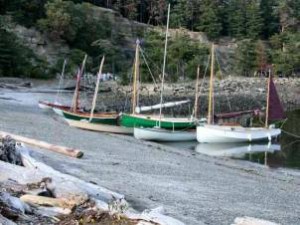
Here’s Wayward Lass (green) and Bluster (white) on the beach at Sucia, among some of the other boats. Chebaccos are a little heavy to pull up and down the beach, but they have no problem nosing in to load and unload. A stern anchor can be helpful getting off again.
(John Kohnen photo)
But Chuck and Randy can speak for themselves and describe the changes they made.
Here’s Chuck, about Full Gallop
Full Gallop incorporated several modifications, including a raised cockpit sole, raised and widened cabin, a bridge deck, curved seats and footwell sides, and a bowsprit. The raised sole was inspired by the need to keep the boat at a dock, and so be self-bailing thru Oregon’s rain. The added plus was a huge storage space under the floor, accessed by a watertight plastic hatch.
The cockpit floor is an extension of the rear ‘slosh pit’ floor at the stern. I didn’t want thru-hulls, so extended the floor such that it would drain thru large limber holes and out the stern. The floor extends forward to a bridge deck that’s set even with the centerboard trunk, with the bridge deck ending about 4” above the cockpit floor level. The floor is pitched about 1” overall, to drain to the rear.
The bridge deck extends 2’ back from the rear cabin bulkhead, and is designed with access on one side of the C/B trunk from outside thru a weatherstripped lid, and the other side accessed from inside the cabin. Part of the cabin bulkhead was removed to provide the inside access, and the area reinforced.
The result is vastly increased storage under the cockpit sole accessed thru the watertight hatch, and additional storage inside the bridge deck, accessed on one side from the cockpit, and the other from inside the cabin. The storage areas are quite deep, averaging over 14” deep in most places, and low in the hull. The shallower footwell doesn’t seem to be a problem, as the coamings are generous and the seats relatively wide.
I set a full-length carlin to support the deck, cabin sides, and seat backs and coamings, with decks approximately 9” wide at the cabin. This let me slope the seat backs outward and cabin sides inward, primarily for aesthetics. A mahogany block is set at the transition between seat backs and cabin sides, which align only at the deck level. The cabin is 2 ½” higher in the back and 2” higher forward, and probably 6” wider throughout. I installed heavy breasthooks to support oak mooring bitts and a bowsprit that butts to the front of the cabin, with that area and the area of the mast slot heavily reinforced with ply and oak gusseting. No gorgeous Jonesport cleat, like on Wayward Lass!
I flew a jib from the bowsprit until I pulled the luff wire out of it. I’ll experiment with setting the jib flying, tho I use a rope stay to steady the free-standing mast. In all, the modifications are not readily apparent unless you’re familiar with the design, but all made good sense for my needs and work passably well. I value the storage, and yes, Jamie, you can sleep below without moving everything!
Now, from Randy, about Bluster
Starting from the bow and working aft are some of the personal modifications I have worked into the construction of Bluster
Cabin
Bluster’s cabin roof has been raised two inches from the drawings and the sides extended out flush with the coamings. These changes add to the interior space at the expense of side deck width, reduced to about eight inches, which with the toe rail has not been a problem move forward.
A small bridge deck straddles the centerboard trunk with cut away in the bulkhead to allow access to this storage area from the cabin.
Bowsprit
This is a plank style bowsprit (overall 1.25”x9”x26”) that is contoured on the inboard end to match the curve of the forward cabin top face. A galvanized steel, two part bracket is bolted to the forward end as an attachment point for the forestay. The 5 kg Claw anchor resides on a roller in the center of the plank, aft of which is the main mooring cleat. The 15 ft chain and 150’ x 3/8” anchor rode pass through the side deck via a deck pipe and are stored in a bucket within the forepeak.
(Randy Wheating photos)
Tabernacle and Rigging
The tabernacle was welded up from ½” aluminum that is through bolted astride a double thick (one inch) bulkhead. The mast pivots on the upper bolt and the lower bolt is inserted and fastened once the mast is standing. The 1/8” ss shrouds are attached to galvanized chain plates with turnbuckles and are left in place when the mast is lowered. The forestay attached easily to the bowsprit bracket via a pelican hook. The gaff bridle is also made of 1/8” ss wire rope. Setting up is fairly simple – the mast is manually hinged into place, the lower tabernacle bolt inserted (temporary hold). The forestay in fastened via the pelican hook. Boom and gaff jaws and two sail luff ties fastened to mast and hoist away. In the lowered position the mast, boom and gaff with sail attached, and mizzen rest in holding fixture on the cabin top and a crutch in the cockpit.
Transom and Motor Well
The motor well is slightly smaller than show in the drawings to just fit two Honda gas tanks, one forward and one aft of the mizzen/rudder post. The transom is constructed from one piece with a simple cut out for the 5 hp Honda. Holes in the transom facilitate motor well drainage. The stern deck is also a single piece with cutouts for the mizzen and rudderpost. There is no cut away between the cockpit and the motor well as shown in the drawings.
Other Modifications
- Blocks on gaff halyard and centerboard pendant to ease lifting.
- Wooden strips on seat fronts to fit cross boards that can then hold floorboards flush with seat tops creating a huge cockpit sleeping platform. Boom tent to follow.
- Watertight inspection hatches on cockpit bulkheads (accessible from cabin and lazarets) to create a usable yet watertight compartment.
- Tiller extension for comfy steering.
Now it’s me again – Jamie speaking, I mean.
I haven’t given a lot of details about Wayward Lass, since there are several articles about building and sailing her already. But if you want to compare Randy and Chuck’s modified boats to what you’ll get by following the plans, look back through some previous newsletters. There’s a good picture in the last issue.
I like the bridge deck idea, I considered this myself, but decided against it. Don’t remember why, now. The wide cabin is a popular idea – other builders I’ve corresponded with or met have spoken of making the cabin as wide as the cockpit. The raised cabin would be welcome when you’re inside it, but I think it would have to be very carefully done or it would spoil the beauty of the design. That said, however, I have to admit that both Full Gallop and Bluster look pretty good!
The hulls on all three boats here are built as designed, at least below the waterline. Apart from weight and how it’s distributed, the only things left to make a difference in performance are the sails.
Bluster and Full Gallop have jibs set on bowsprits – I think jibs on Chebaccos need the bowsprit to work properly. I also have a jib, built according to the sail plan and set with the tack at the bow, (no bowsprit) but I rarely use it as it doesn’t work very well. Going to windward, it luffs when it is not sheeted in and upsets the flow of air to the main when it is. It does work when boomed out for running, but it’s too small to be very effective. It showed some potential when used in stronger winds with the mizzen, and no mainsail, but I haven’t explored that fully. I think it might be useful if you’re caught out in bad weather and have room to run. I think you could reach all right too, but would make a lot of leeway.
I don’t plan to add a bowsprit, but I am considering a reaching (asymmetrical) spinnaker for light winds, as shown on page 131 of Bolger’s 100 Small Boat Rigs. This would be set on a spinnaker pole that would serve as a very long bowsprit. I’m still working out the details, but stay tuned.
Wayward Lass’ main sail is different from the others, having eight inches of roach – all other things being equal, the roach adds a little speed. The downside is that battens are necessary to support the roach, and the batten pockets chafe. I’ve replaced these once already because I made them too light and two of the three battens wore right through the forward ends.
Both Chuck and Randy built their sails from Sailrite kits, and are very pleased with them. I can confirm that they look great, and seem to set well. Quiet a few builders have used Sailrite kits for main and mizzen now, and all the comments I’ve heard have been positive. So if you can’t borrow the school gym to lay out your sail, or don’t want the design headaches, Sailrite looks like the way to go.
At Sucia we didn’t do any controlled tests or scientific comparisons (also called races), but one day everyone sailed over to neighboring Patos Island. Wayward Lass was almost the last to get away from the anchorage, so I was out of the action and didn’t even see Full Gallop and Bluster sail together. However, I heard they performed about level with each other, and both skippers came away pleased with their boats.
The next day we were a little more organized, getting all three Chebaccos out together so John Kohnen could take some pictures for us. Outside of the WoodenBoat article comparing cold-moulded, plywood and lapstrake versions, this is the only time I know of that three Chebaccos have sailed in company.
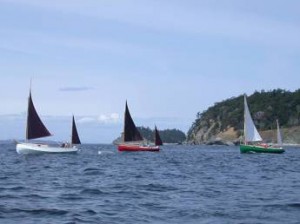
Three Chebaccos, with Sucia Island in the background. Bluster is in the lead, Full Gallop is in the middle and Wayward Lass is coming up behind.
(John Kohnen photo)
We can’t say yet which boat will be faster. On this occasion, Wayward Lass had an edge, since Chuck was still getting to know Full Gallop, and Bluster was towing a dinghy – very small, but still a handicap. However, the rendezvous was enjoyed by everyone who attended and we plan to hold another in 2005. We’ll be sure to organize some real match (grudge) racing then, so stay tuned!
***
Racing Micros and Floating Sheep Bridges – David Lewis
Never have editors for friends. “Write an article for me,” they whine.
“Where’s my article I bullied you into agreeing to?” I swear, it never ends.
As if I didn’t have enough to do, what with keeping my sheep wormed and happy, getting my steers to the butcher, finding customers, building the infrastructure for a farm while working full-time planning new telecom and network systems for an entire company move.
Here comes Richard, “You live five minutes from a lake, and you have a Bolger Micro that you haven’t sailed in two years. Surely there’s a sailing story in there somewhere.”
Uh huh.
Ok, let’s see. Well, something rather amazing did happen the other day.
Not so much sailing as “rafting” but…
My farm is split down the middle by a creek which, with all the rain we’ve been having, is not a small one these days. There’s only one spot that is passable by man or truck and you don’t do it without getting wet.
Now that’s just fine for my cattle, they’ll plod through anywhere that’s below their chests. But my sheep are a bit more finicky. And shorter.
So I decided it was time to build a bridge. Now shoestring budget that I have, I wanted to do this for next to nothing. In fact, free was a good target. I could have gone and bought a culvert, buried it to 40%, put fill and cement around it, and had a decent bridge for, oh, I don’t know, $2000, $5000, something like that. Or I could use my muscles, my ingenuity, and materials I already had and keep the cost below a hundred.
I have about two hundred railroad ties sitting around collecting sheep poop. Some of them are light (well, relatively light) and some of them are so heavy I can barely get them into the truck. Heavier than water in other words. Being a bit lazy, I used whatever weights happened to be on the top of the pile. Some were heavy, some were light.
I hauled fourteen of them out to the crossing and laid two parallel to the flow and ten across those two. I tied them together with three poly-ropes and laid the remaining two ties crosswise on the lower and the upper end – to make a two-sided “bowl” that I could then fill in with a layer of rocks and dirt on top of that. Then I began filling in either side with rocks, the plan being to build up ramps that would be level with the top of the
bridge.
I went and bought some threaded rod and some of those aluminum tent stakes. I would put two rows of threaded rod through the top two ties, parallel to the creek flow. I would drive four stakes down through the top of the two ties. This would help prevent those ties from pushing out as weight was added between them.
Then there was about a week where I didn’t get a chance to work on my bridge. Then it rained. Not heavy but it kept up for most of the day.
Then yesterday I went to put in my threaded rod.
I’m sure you’ve all figured out what happened. Bridge gone. Just not there.
I started tramping down creek to find it. I passed numerous spots where I was sure it could NOT have passed, it being so shallow there. I finally found it about a mile downstream, hung up on a fence across the creek and still tied together with the poly rope.
Knowing how heavy those dang things are, it still amazes me that it made it that far. Now I get to figure out how to pull the timbers out of there. Could a culvert and cement be in my future?
***
On Contributing – Chuck Leinweber
If you are reading this article, you probably had a few minutes to kill and happened here by accident. Perhaps you have this site bookmarked and check it regularly for new material. Maybe you’re sitting at your desk taking a coffee break, or using your laptop at the beach in front of a five star hotel with WIFI. If you are here, you probably like reading about boats and boatbuilding. Where do these articles come from?
There are literally thousands of people writing blogs. Who needs more blather on some website? How much is there that can possible be of interest to some boatbuilder? Admittedly, Duckworks does post something new each day, and the Chebacco News posts great articles, but we’d be willing to bet you would like to see more about the subject you are particularly interested in.
Which begs the question. Do you have an obligation or better yet a desire to add your opinion or experience? As an editor, I can categorically tell you that if you take the time to put your thoughts down, they will be appreciated. Not just by frustrated editors like Richard and me, but also by all the other folks out there who are waiting to read what you have to say.
Whether you want to write about a Chebacco or some other boat design, you may be unsure how to proceed. Rule one. Just get the words down. Type one word and then the next, and keep right on going. What are some guidelines? I thought you’d never ask.
Your readers want to know how you did everything, especially if you came up with a novel way of accomplishing some of the more tedious parts of boat building. The process is always of interest. Just this afternoon, I puzzled over the assembly sequence of the boat I am building. The instructions given in the plans are not always minute, and can sometimes be called obscure, so the voice of experience (yours) is always appreciated. And if you’d like to wax poetic, rant and rave, or better yet, insert some humor, please feel free. Your voice is what makes what you write special.
If possible, include photos. This implies that you thought you might want to write something before you started building or before you took that cruise. We always carry a camera, except the one time we didn’t even know it was still in the truck until we were ten miles from out launch point. A digital camera is especially nice for web articles, and also nice because you can take about a million photos and never need to load new film. Let the editor know where you would like each photo to be placed in the article by numbering them and indicating where each should be. Digital photos are easy to enhance, easy to crop, easy to save in a compressed format that web editors like. Most of us have scanners and can also use regular photos as well.
When you are done, ask a friend, your significant other, or the guy sitting next to you to read it through. It is always hard to critique your own work. Have them check for clarity first. Does it make sense; does it read smoothly. If they have grammar skills, take advantage of them. If you intended to be humorous, it is good sign if they laugh out loud. If they ask you where they can go to start boat building, you know you are on the right track. If no friendly readers are available, at the very least, RUN YOUR SPELLCHECK and read the piece out loud to yourself.
I will throw in a bit of grammar advice. Don’t use the word ‘then’. (And then we did this, and then we did that, and then she…..) Don’t start a sentence with the word ‘and’ or ‘so’. Get rid of words that don’t need to be there, especially if they repeat what you just said. The words ‘very’ and ‘really’ can almost always be omitted. .
Last but not least, a little abstract speculation about what makes one article stand out from all the rest. The very best are like the ones you hear when sitting around a fire at a messabout. The fish tales, the shark tales, the alligator tales. The time you fell in and the boat sailed off without you. Tell what really happened—don’t pretty it up. We want to hear about the good, the bad, and the ugly. Let your personality, your opinions, your unique point of view loose in what you write. Your public is out there waiting.
This website lives by submissions. Richard depends almost totally on readers for content. I happen to think that this makes for honest and real reading – the experiences of amateurs who get no pay for their writing and no commissions for any products that they promote.
Editors are pretty flexible, but we do have some druthers. We like to have articles in some form of text format. You can copy and paste the article into the body of an e-mail, or you can attach just about any kind of word processor file to an e-mail instead. A file on a floppy disk or CD mailed by regular snail mail will work. I have even typed up hand written material, though that is a bit of trouble. Pictures can be sent for scanning, and will be returned promptly. If you have digital versions of the photos, they can be e-mailed or sent on a disk. The best format is .jpg without too much compression. Send as many as you need to illustrate the article. We may cull a few.
If you have certain places you want pictures to go, simply make an insertion note at the appropriate place in the text <**insert boat01.jpg**> or let us do the picture placement. We’re pretty careful.
Thanks for taking the time to write up the details of your project. I assure you it will be of great interest to boat builders and wannabees.
Chuck Leinweber
Duckworks
608 Gammenthaler
Harper, TX 78631
www.duckworksmagazine.com

